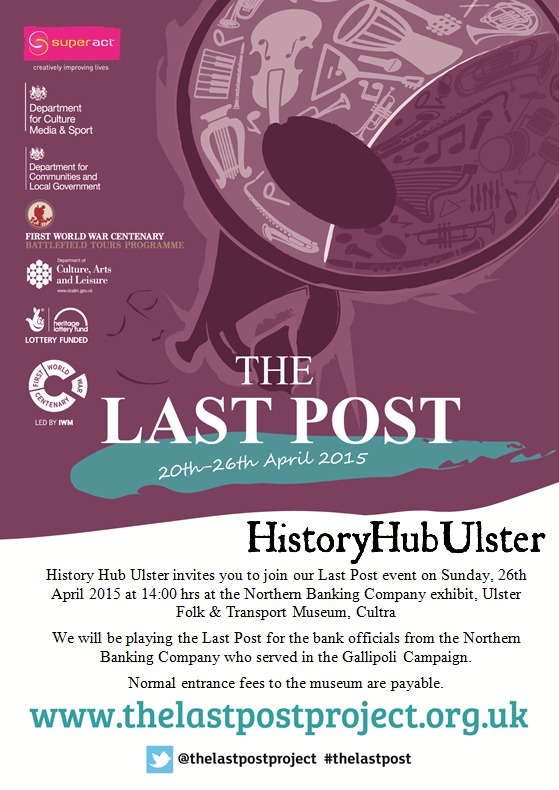Dalchoolin
…. A history by Richard Graham
The house, its location and the people who lived there …
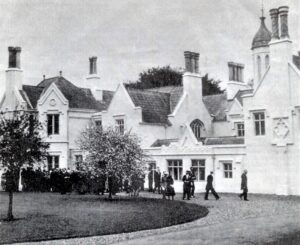
The Dalchoolin estate extended from the Belfast Road at Cultra to the County Down shores of Belfast Lough the house of which was undoubtably one of the finest and most unique properties on the Co. Down Coastline in the 19th century.
The original house on the site, a much plainer property than that pictured, was known as Wellington or Wellington Lodge and stood on land leased from the Kennedy family of nearby Cultra Manor (now the Ulster Folk Museum) under ownership of the Earl of Clanbrassil. The first lease was granted in 1815 to William Crawford (1801 – 1872) of nearby Crawfordsburn. 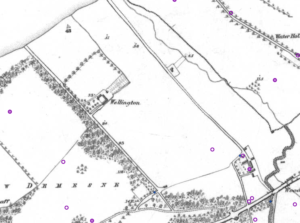 He was the 4th son of Captain Arthur Crawford who resided on Donegall Place when it was still residential but who later moved to Bloomfield House on the Co. Down side of the town of Belfast. Arthur made his fortune as an adventurer in the army of the Honourable East India Company reaching the rank of Captain. He was also a Major in the Bangor Regiment of Volunteers and a member of the prestigious First Presbyterian Church on Rosemary Street. It was at Dooneen on Donegall Place, that William was born.
He was the 4th son of Captain Arthur Crawford who resided on Donegall Place when it was still residential but who later moved to Bloomfield House on the Co. Down side of the town of Belfast. Arthur made his fortune as an adventurer in the army of the Honourable East India Company reaching the rank of Captain. He was also a Major in the Bangor Regiment of Volunteers and a member of the prestigious First Presbyterian Church on Rosemary Street. It was at Dooneen on Donegall Place, that William was born.
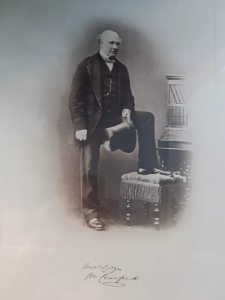
William Crawford studied law becoming a leading solicitor with practices in both Belfast (Arthur Street) and Dame Street in Dublin. The practice of Crawford, Lockhart, Black still survives on Linenhall Street to this day. It was from the success achieved in this profession that he was able to purchase outright Wellington Lodge from the Kennedy estate in 1847. William married Jane Cairns, one of the most eligible beauties of the day and daughter of William Cairns of Parkmount Estate on the Shore Road leading from Belfast to Carrickfergus. This was a shrewd move on Crawford’s part, as not only did the marriage bring him increased status, but also a generous dowry with which he could build a new house.
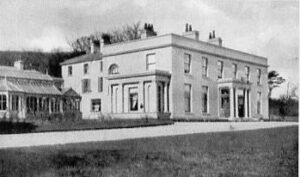
William Cairns was a captain in the 47th Regiment coming from a family of Scottish origin and settling in Ireland in 1715. His son, and Jane’s brother, Hugh McCalmont Cairns (left) was also called to the bar and worked his way up to become Lord High Chancellor of Great Britain, becoming Earl Cairns and Viscount Garmoyle in 1878. His legacy on the legal structure of the United Kingdom was substantial.
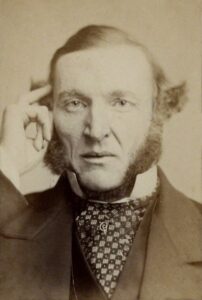
With his position in Ulster society secured, William Crawford set about enlarging the original property, transforming it into a Picturesque Tudor Revival Manor House and renaming it Dalchoolin, in recognition of his Scottish roots, his great grandfather (also William) having purchased the estate of Crawfordsburn from Lord Clanbrassil upon his arrival in Ireland in 1670.
Cultra had been sparsely populated until the mid-1800s, but it was the opening of the Belfast & Holywood Railway in 1865 which created the desire to develop the area for superior housing. This development was very much down to the ambitions of the Kennedy family of Cultra Manor. The railway passed through the Dalchoolin estate with access to the house being by a rather attractive bridge over the new single track.
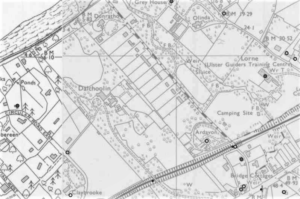
Dalchoolin had two substantial gate lodges at the entrances to the estate. The north lodge existed from the time of the original Wellington Lodge with the south lodge being added later around 1855, when William Crawford altered the house. The second lodge was a single story three bay structure with serrated timber bargeboards and would play an integral part in the running of the estate for over 100 years.
In 1867, Crawford sold Dalchoolin and its estate to James Moore (1811- 1884) who around 1870 extended the property even further adding to it several additions which realised its final eccentric manifestation!
Moore was a director of the Belfast Banking Company, where he served on the board of superintendence, along with other leading merchants of the town of Belfast, including Arthur Sharman Crawford of Crawfordsburn. He also served as a magistrate (JP) for Co. Down.

He was partner in the linen firm of Moore & Weinberg, since its establishment in Belfast in 1855, but unlike the Belfast Bank he didn’t actively manage the business. The company had a magnificent linen warehouse on Linenhall Street (right) but what is more interesting is that the company’s original premises were located on Donegall Square North, in the building which now houses the Linenhall Library!
A Conservative in politics, Moore was somewhat different to his contemporaries in that he maintained an unobtrusive profile in public life, having membership of the Unitarian church in Holywood and supporting the Children’s Hospital, just one of his charitable works
Moore did however move in the highest of social circles – his daughter marrying Alfred Chenevis Trench, the son of the Archbishop of Dublin.
Moore’s architect is not recorded, but is possibly John Miller who carried out similar work in the area, influenced no doubt by Ormeau House, the 19th century home of the Marquess of Donegall, before that family removed to Belfast Castle on the slopes of Cave Hill.

Dalchoolin as seen in this later photograph, was 1 ½ to 2 stories high in stucco and stone with distinctive mullioned windows. Its roofline was defined by a multiplicity of gables and finials, with an amazing array of ‘barley twist’ chimney pots.
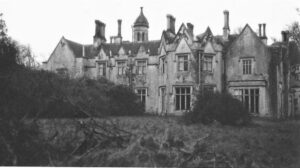
An ogee-domed octagonal turret was added by Moore in an attempt to unify the ‘chaos’ of the two designs, as well as signposting the entrance porch, again designed in Tudor fancy dress – buttressed, pinnacled and crenelated!
James Moore died rather suddenly on the evening of Thursday 16th October 1884 following his attendance at a meeting of the Belfast Bank, where he suffered a severe attack of gout (too much port!) after which his widow Eliza lived on at Dalchoolin until her death in 1895.
The estate was then purchased by Edwin Hughes, who’s family would reside there for the next 70 years. The Hughes family were wealthy landowners in Ireland with Thomas Hughes (1808-1885) of The Bush, Co. Antrim owning 4,332 acres of land in Co. Roscommon and 189 acres in Co. Antrim.
Edwin Hughes, the eldest son of Thomas, was born on 19th September 1852 and in 1886 married Emma Sophia Rhodes, daughter of Henry Perry Rhodes, Esq originally of Queens County and resident at Glenaok, Crumlin, Co. Antrim. After having been called to the bar, Edwin Hughes, like the house’s previous owner, become a prosperous and successful solicitor in the town of Belfast. Before moving to Dalchoolin, Edwin Hughes had taken a lease on Mertoun Hall at nearby Holywood, one time home of the ‘Squire of Holywood’ John Harrison, who later lived at Holywood House. He was appointed to serve as High Sheriff for Co. Roscommon in 1893 and for Co. Down in 1902. In September 1917 was appointed by the Marques of Londonderry (Lord Lieutenant for Co. Down) to serve as Deputy Lieutenant for the county.
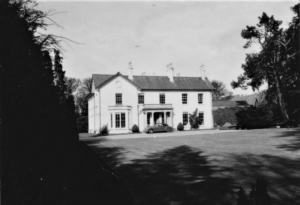
The Hughes family were highly respected horse breeders and took part in many equestrian events including the Co. Antrim Polo Club, the East Antrim Hunt Point to Point races and the Co. Down Staghounds. Soon the estate became famous for equestrian prowess and fine stable accommodation – much of which was captured on film by the camera of Mrs Hughes as can be seen in these photographs …

Edwin and Emma had one son and two daughters – their son Thomas William Gillilan Johnston Hughes was born at Dalchoolin on 30th March 1889. He was educated at Pembroke College, Cambridge and went on to study law. In October 1911, he entered King’s Inns, being called to the bar as a barrister by the Lord Chancellor in June 1914.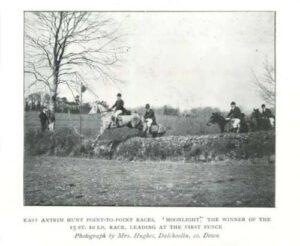
However, with the outbreak of the First World War in 1914, he was one of the first soldiers at the age of 25 to be sent to France on 17 August being a member of A Squadron of the North Irish Horse, of which he had been commissioned as 2nd Lieutenant in June 1910.
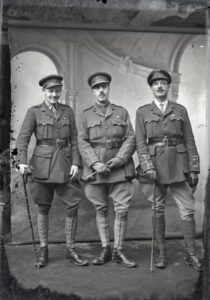
Lieutenant Hughes (pictured on the left) saw active service throughout the period of the First World War in France and Belgium, being promoted captain in November 1915 and receiving the 1914 Star, the British War Medal, Victory Medal and mentioned in Field Marshall Haig’s dispatches for his bravery and services in May 1917.
After the war, Hughes remained an officer of the North Irish Horse. When he relinquished his commission on 30 March 1934, having reached the age limit for officers, he was granted the honorary rank of Major … a title he was often referred to for the rest of his life! He was a member of the prestigious Ulster Club on Castle Place.
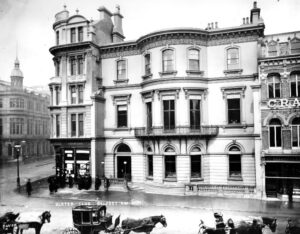
The Major’s father Edwin Hughes died at Dalchoolin on 26th November 1919 leaving a personal estate of £137,635 – £500 of which was given to the Presbyterian Orphan Society and £300 to the Belfast Royal Hospital, after which he, as the only son, inherited Dalchoolin as the family home. A memorial tablet was unveiled and dedicated to Edwin by the Lord Bishop of Down at Belfast Cathedral during a service of thanksgiving on 3rd September 1920.
Major Hughes, like his father, was elected to serve as High Sheriff of Co. Down by the Governor, the Duke of Abercorn in 1942. The high sheriff is theoretically the judicial representative of the Queen in the county, although by that stage it had largely become a ceremonial post. His mother Emma died at Dalchoolin in March 1946, aged 83 years of age.
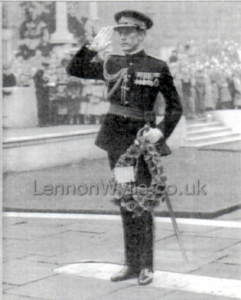
Life at Dalchoolin was vividly captured by Major Hughes daughter Elizabeth Anne (1926-2005) in an article on her upbringing in the big house. In one of the society weddings of the year, on Friday 12th May 1950, Anne married Major William Norman Brann, with the reception being held, naturally, at Dalchoolin.
During the Second World War Norman Brann was among more than 300,000 British troops evacuated from Dunkirk, while he later saw combat in the Far East during that same conflict before returning to run a successful food importing business (Beck & Scott) while rationing was still in force.
Anne could claim her heritage back to Brian Boru, the High King of Ireland, and was the great granddaughter of William Smith O’Brien, (right) Irish Nationalist MP for Limerick 1835-1849 and founder of the Young Ireland Movement. Although a member of the Anglo-Irish Ascendency, O’Brien was sentenced to death in 1848 by the British Authorities, a sentence which was later commuted with him being sent to Tasmania. Such colourful ancestors!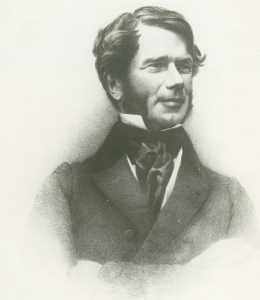
She tells of the butler, Martin Fitzsimmons, who looked after the Hughes family for over 60 years at Dalchoolin. Martin lived with his wife, the cook at the big house, in the South Gate lodge. He would take early morning tea up to Elizabeth’s’ mother and father, before stoking all the fires in the house, and then serving morning elevenses, lunch in the dining room at 1:00pm, afternoon tea, followed by dinner at 7:30pm and finally nightcaps at 9:00pm!
Anne also had a governess, Rosie, who in addition to educating the children, taught them to climb trees and how to lay fires in the grounds on which to cook Baked Potatoes!
There was a walled garden of about an acre with herbaceous borders, a rockery in a ruined cottage, many rose beds and a pond with a fountain. There was a greenhouse with a vinery and peaches. Another acre accommodated more fruit trees and vegetables and fed eight households! Other areas of the estate were set aside for shrubs and specialist trees. These were all tended by ‘Old Magill’ the head gardener, and her father who had a “tremendous knowledge of plants and plant care.”
When she married, Anne and Norman moved to Drumavaddy in the Craigantlet Hills. Lt Colonel Norman Brann was awarded the OBE, ERD, and like his in laws became a Justice of the Peace and Deputy Lieutenant and then Lord Lieutenant for Co. Down (1979), a position he held for 11 years!
Meanwhile, back at Dalchoolin, the Major absorbed himself in everything to do with horses, becoming one of Ulster’s Leading Horse Breeders. An outstanding judge of horses, his hunters were regular winners in showrings and on racecourses all over Ireland. He was a lifelong member of the Co. Down Staghounds and the North Down Harriers with whom he hunted regularly.
Major Hughes died at Dalchoolin in 1963, aged 74, leaving a wife, son and daughter.
It was at this stage that the family decided that the upkeep of such a large house as Dalchoolin was becoming increasingly impossible. They did not want to sell to developers and risk the house being demolished so they decided to sell it to the Northern Ireland Government in 1963, thinking it would keep it in good repair and perhaps open it to the public. However, the building fell into disrepair and, overtaken with rot, was demolished after having lain empty for many years.
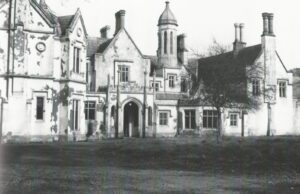
The site of the estate was eventually earmarked for the transfer of the rather cramped Ulster Transport Museum which at that time was located on Witham Street, close to the Holywood Arches in East Belfast.
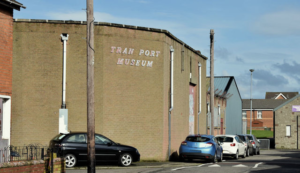
The building, a converted warehouse, was no longer fit for purpose, and at last the benefits of moving to Cultra were realised, although too late for the big house to be part of the plans.
The Ulster Folk Museum had opened to the public in 1964 on the site of Cultra Manor (acquired in 1961), the former home of the Kennedy family, just across the road from Dalchoolin. It amalgamated with the Transport Museum on Witham Street in 1967, but it was not until 1993, that the Transport Museum moved into new rail and road galleries on the site of Dalchoolin at Cultra.
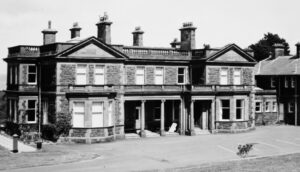
The rolling stock and exhibits could be transported by rail to the new proposed museum building, and along with ample room for expansion and car parking, the site was prepared for a new lease of life for the Transport Museum.
The newly named Ulster Folk and Transport Museum opened at Cultra in 1993 on a 68-acre site with the transport galleries (one of which was named Dalchoolin) being subsequently expanded in 1996.
In 1998, the Ulster Folk and Transport Museum merged with the Ulster Museum and the Ulster-American Folk Park to form the National Museums and Galleries of Northern Ireland, now National Museums Northern Ireland.
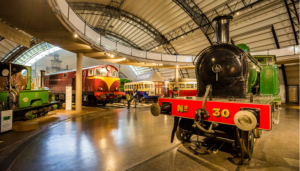
In her later years, Anne Brann (nee Hughes) moved to the Somme Nursing Home at Craigavon House, where she was visited by Princess Anne on one of her visits to the province. It had been established in 1914 to provide treatment, as a UVF Hospital, for servicemen returning from the First World War. Her father was a major benefactor to this hospital. Colonel Brann was also an Aide de Camp to princess Anne’s uncle for 20 years and therefore she had plenty to talk about with the Royal.
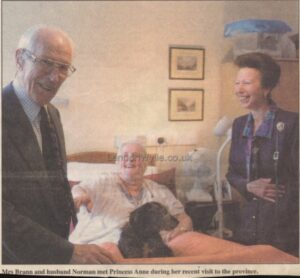
She died on 29th June 2005, aged 79 years, followed by the death of her devoted husband Colonel Norman Brann on 31st December in the same year.
She is survived by her three children, Victoria, Stephen and Catherine, one of which has inherited her fathers and grandfathers love of horses – so much so her racehorse is called – what else? – but Dalchoolin!
Written by History Hub Ulster Member Richard Graham

